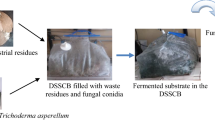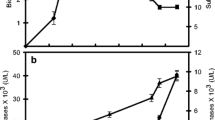Summary
The behaviour of a drum fermentor and a column fermentor during the sporulation ofPenicillium roqueforti on buckwheat seeds is presented. The main problem encountered during the course of a cultivation is the free water released (about 0.1 ml/g dry matter) which must be removed from the medium. The rotation of the drum fermentor may disturb the growth and the sporulation. The column fermentor thus represents the best way to perform batch cultivation of the fungus: 109 external spores/g dry matter are obtained.
Semi-continous cultivation, with sequential emptying and filling, is performed in 1-liter bottles. This kind of cultivation may give a maximal average productivity close to 9.2·106 external spores/g dry matter per hour. A drum fermentor, rotading only when emptying and filling, could represent an alternative to perform this kind of cultivation.
Similar content being viewed by others
References
Abdullah AL, Tengerdy RP, Murphy VG (1985) Optimization of solid substrate fermentation of wheat straw. Biotechnol Bioeng 27:20–27
Aidoo KE, Hendry R, Wood BJB (1982) Solid substrate fermentations. Adv Appl Microbiol 28:201–237
Arima K (1964) Global impact of applied microbiology. Wiley, New York
Bartet B, Prebois JP, Deschamps F (1981) Etude en vue de la production industrielle de spores fongiques. Report no 431, IRCHA, Vert-le-Petit, France
Cuero RG, Smith JE, Laley J (1985) A novel containment system for laboratory-scale solid particulate fermentations. Biotechnol Letters 7:463–466
Deschamps F, Huet MC (1984) β-glucosidase production byAspergillus phoenicis in solid state fermentation. Biotechnol Letters 6:55–60
Kargi F, Curme JA (1985) Solid-state fermentation of sweet sorghum to ethanol in a rotary-drum fermentor. Biotechnol Bioeng 27:1122–1125
Hesseltine CW (1977a) Solid state fermentation. Part 1. Proc Biochem July–August 24–27
Hesseltine CW (1977b) Solid state fermentation. Part 2. Proc Biochem Nov 29–32
Hrubant GR, Orton WL, Rhodes RA (1976) Am Soc Microbiol Abstr 182 as cited by Hesseltine, 1977b
Hussong RV, Hammer BW (1935) The preparation of mold powder for blue-veined cheeses. J Dairy Sci 18:559–601
Levenspiel O (1979) The chemical reactor omnibook. OSU book Stores Inc., Corvallis
Lindenfelser LA, Ciegler A (1975) Solid-substrate fermentor for Ochratoxin A production. Appl Microbiol 29:323–327
Lotong W, Suwarnarit P (1983) Production of soy sauce koji mold spore inoculum in plastic bags. Appl Env Microbiol 46:1224–1226
Matheva E, Djelveh G, Larroche C, Gros JB (1984) Sporulation ofPenicillium roqueforti in solid substrate fermentation. Biotechnol Letters 6:97–102
Meyers E, Knight SG (1958) Studies on the nutrition ofPenicillium roqueforti. Appl Microbiol 6:174–178
Miller GL (1959) Use of dinitrosalicylic acid reagent for determination of reducing sugars. Anal Chem 31:426–428
Moo-Young M, Moreira AR, Tengerdy RP (1983) Principles of solid-substrate fermentation. In: Smith JE, Berry DR, Kristiansen B (eds) The filamentous fungi vol IV, Edward Arnold, London, pp 117–144
Raimbault M (1981) Solid state fermentation: growth of filamentous fungi in starchy substrate. ORSTOM 127
Sansing GA, Ciegler A (1973) Mass propagation of conidia from several Aspergillus and Penicillium species. Appl Microbiol 26:830–831
Sato K, Nagatani M, Sato S (1982) A method for supplying moisture to the medium of a solid-state culture with forced aeration. J Ferm Technol 60:607–610
Silman RW (1980) Enzyme formation during solid-substrate fermentation in rotating vessels. Biotechnol Bioeng 22:411–420
Singh K, Sehgal SN, Vezina C (1967) Large-scale transformation of steroids by fungal spores. Appl Microbiol 16:393–400
Stein MW (1965)d-glucose determination with hexokinase and glucose-6-phosphate dehydrogenase. In: Bergmeyer HU (ed) Methods of enzymatic analysis, Acad. Press, New York, London, pp 117–123
Steinkraus KH (1983) Industrial applications of oriental fungal fermentations. In: Smith JE, Berry DR, Kristiansen B (eds) The filamentous fungi, Vol. IV, Edward Arnold, London, pp 171–189
Sumner JB, Howell SF (1935) A method for determination of invertase activity. J Biol Chem 108:51–54
Thivend P, Mercier C, Guilbot A (1972) Determination of starch with glucoamylase. In: Whistler RL (ed) Methods in carbohydrate chemistry, Vol. VI, Academic Press, New York, London, pp 100–105
Thom C (1930) The Penicillia, Bailliere, Tindall and Cox, London
Underkofler LA, Fulmer EJ, Schoene L (1939) Saccharification of starchy grains mashes for the alcoholic fermentation industry — mold amylase. Ind Eng Chem 31:734–738
Vezina C, Singh K (1975) Transformation of organic compounds by fungal spores. In: Smith JE, Berry DR (eds) The filamentous fungi, Vol. I, Edward Arnold, London, pp 158–192
Vogel AI (1961) Quantitative inorganic analysis including elementary instrumental analysis, 3rd edition, Longmans, London, pp 249–252
Wang DIC, Cooney LC, Demain AL, Dunnill P, Humphrey AE, Lilly MD (1979) Fermentation and enzyme technology. John Wiley and Sons, New York
Author information
Authors and Affiliations
Rights and permissions
About this article
Cite this article
Larroche, C., Gros, JB. Spore production ofPenicillium roqueforti in fermentors filled with buckwheat seeds: batch and semi-continuous cultivation. Appl Microbiol Biotechnol 24, 134–139 (1986). https://doi.org/10.1007/BF01982556
Received:
Revised:
Issue Date:
DOI: https://doi.org/10.1007/BF01982556




